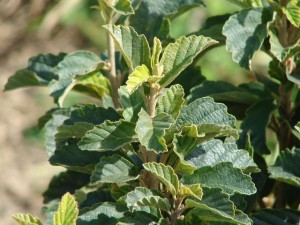Vernal witchhazel (H. vernalis) is a dense growing 8 to 12 foot native shrub which blooms in mid-winter in the Southern Appalachian region (USDA hardiness zones 6 and 7). It is winter hardy to zone 4. Small ½ inch wide yellow flowers, flushed red at the base, emit a pleasant witchhazel aroma in the February garden. Often, it’s the fragrance that attracts gardeners to the small strap-like flowers blooming in the winter garden.
New leaves flaunt a reddish purple tint in early spring. The 2 – 5 inch long by 2 – 3 inch wide leaves are medium green and remain pest free throughout the growing season. Fall leaf colors gradually change from green to yellow to gold. Unfortunately, many dead leaves often hang on through the winter, concealing many of the winter flowers. Vernal witchhazel’s root system tends to sucker prolifically. The branch wood displays a pale gray color.
‘Quasimodo’ is a compact 3 – 4 foot high shrub, slightly taller than wide. This diminutive cultivar is an excellent choice for a small garden. Quasimodo was hybridized and introduced by Pieter Zwijnenburg in the Netherlands. Quasimodo drops most leaves in late fall so that its burnt orange flowers are in plain sight in the mid-winter landscape. Winter flowering period may last 3-4 weeks.
Vernal witchhazel grows in full sun to moderate shade and requires little extra care. The soil should be adequately drained and mildly acidic.


 Posted in
Posted in 
